Application of Edible Insect Flour as a Novel Ingredient in Fortified Snack Pellets: Processing Aspects and Physical Characteristics
Abstract
:1. Introduction
2. Materials and Methods
2.1. Raw Materials
2.2. Snack Pellet Processing
2.3. Evaluation of Selected Physical Properties of Snack Pellets
2.4. Statistical Analysis
3. Results
3.1. Processing Aspects of Snack Pellets
3.2. Physical Properties of Snack Pellets
3.3. Principal Component Analysis
4. Conclusions
Author Contributions
Funding
Data Availability Statement
Conflicts of Interest
References
- Berti, G. Sustainable agri-food economies: Re-territorialising farming practices, markets, supply chains, and policies. Agriculture 2020, 10, 64. [Google Scholar] [CrossRef]
- Jones, S.W.; Karpol, A.; Friedman, S.; Maru, B.T.; Tracy, B.P. Recent advances in single cell protein use as a feed ingredient in aquaculture. Curr. Opin. Biotechnol. 2020, 61, 189–197. [Google Scholar] [CrossRef] [PubMed]
- van Huis, A.; Van Itterbeeck, J.; Klunder, H.; Mertens, E.; Halloran, A.; Muir, G.; Vantomme, P. Edible Insects: Future Prospects for Food and Feed Security; Fao Forestry Paper; Food and Agriculture Organization of the United Nations: Rome, Italy, 2013; Volume 171, Available online: https://www.fao.org/3/i3253e/i3253e.pdf (accessed on 5 July 2023).
- Musundire, R.; Ngonyama, D.; Chemura, A.; Ngadze, R.T.; Jackson, J.; Matanda, M.J.; Tarakini, T.; Langton, M.; Chiwona-Karltun, L. Stewardship of wild and farmed edible insects as food and feed in Sub-Saharan Africa: A Perspective. Front. Vet. Sci. 2021, 8, 601386. [Google Scholar] [CrossRef]
- Oonincx, D.G.A.B.; van Broekhoven, S.; van Huis, A.; van Loon, J.J.A. Feed conversion, survival and development, and composition of four insect species on diets composed of food by-products. PLoS ONE 2015, 10, e0144601. [Google Scholar] [CrossRef] [PubMed]
- Mlcek, J.; Rop, O.; Borkovcova, M.; Bednarova, M. A comprehensive look at the possibilities of edible insects as food in Europe—A Review. Pol. J. Food Nutr. Sci. 2014, 64, 147–157. [Google Scholar] [CrossRef]
- Ordoñez-Araque, R.; Quishpillo-Miranda, N.; Ramos-Guerrero, L. Edible insects for humans and animals: Nutritional composition and an option for mitigating environmental damage. Insects 2022, 13, 944. [Google Scholar] [CrossRef]
- Stull, V.J.; Finer, E.; Bergmans, R.S.; Febvre, H.P.; Longhurst, C.; Manter, D.K.; Patz, J.A.; Weir, T.L. Impact of edible cricket consumption on gut microbiota in healthy adults, a double-blind, randomized crossover trial. Sci. Rep. 2018, 8, 10762. [Google Scholar] [CrossRef]
- Lucas-González, R.; Fernández-López, J.; Pérez-Álvarez, J.A.; Viuda-Martos, M. Effect of drying processes in the chemical, physico-chemical, techno-functional and antioxidant properties of flours obtained from house cricket (Acheta domesticus). Eur. Food Res. Technol. 2019, 245, 1451–1458. [Google Scholar] [CrossRef]
- Burt, K.G.; Kotao, T.; Lopez, I.; Koeppel, J.; Goldstein, A.; Samuel, L.; Stopler, M. Acceptance of using cricket flour as a low carbohydrate, high protein, sustainable substitute for all-purpose flour in muffins. J. Culin. Sci. Technol. 2020, 18, 201–213. [Google Scholar] [CrossRef]
- Cappelli, A.; Oliva, N.; Bonaccorsi, G.; Lorini, C.; Cini, E. Assessment of the rheological properties and bread characteristics obtained by innovative protein sources (Cicer arietinum, Acheta domesticus, Tenebrio molitor): Novel food or potential improvers for wheat flour? LWT-Food Sci. Technol. 2020, 118, 108867. [Google Scholar] [CrossRef]
- Kowalski, S.; Mikulec, A.; Mickowska, B.; Skotnicka, M.; Mazurek, A. Wheat bread supplementation with various edible insect flours. Influence of chemical composition on nutritional and technological aspects. LWT-Food Sci. Technol. 2022, 159, 113220. [Google Scholar] [CrossRef]
- Jakab, I.; Tormási, J.; Dhaygude, V.; Mednyánszky, Z.S.; Sipos, L.; Szedljak, I. Cricket flour-laden millet flour blends’ physical and chemical composition and adaptation in dried pasta products. Acta Aliment. 2020, 49, 4–12. [Google Scholar] [CrossRef]
- Khatun, H.; Van Der Borght, M.; Akhtaruzzaman, M.; Claes, J. Rheological characterization of chapatti (Roti) enriched with flour or paste of house crickets (Acheta domesticus). Foods 2021, 10, 2750. [Google Scholar] [CrossRef] [PubMed]
- Aboge, D.O.; Orinda, M.A.; Konyole, S.O. Effect of partial substitution of soybean flour with cricket flour on the nutritional composition, in vitro-protein digestibility and functional properties of complementary porridge flour. Int. J. Trop. Insect Sci. 2022, 42, 1137–1145. [Google Scholar] [CrossRef]
- European Union. Commission Implementing Regulation (EU) 2023/5 of 3 January 2023 Authorising the Placing on the Market of Acheta Domesticus (House Cricket) Partially Defatted Powder as a Novel Food and Amending Implementing Regulation (EU) 2017/2470 (Text with EEA Relevance), Document 32023R0005; EU: Brussels, Belgium, 2023. [Google Scholar]
- European Food Safety Authority. Safety of partially defatted house cricket (Acheta domesticus) powder as a novel food pursuant to Regulation (EU) 2015/2283. EFSA J. 2022, 20, 7258. [Google Scholar] [CrossRef]
- David-Birman, T.; Raften, G.; Lesmes, U. Effects of thermal treatments on the colloidal properties, antioxidant capacity and in-vitro proteolytic degradation of cricket flour. Food Hydrocoll. 2018, 79, 48–54. [Google Scholar] [CrossRef]
- Kiiru, S.M.; Kinyuru, J.N.; Kiage, B.N.; Martin, A.; Marel, A.K.; Osen, R. Extrusion texturization of cricket flour and soy protein isolate: Influence of insect content, extrusion temperature, and moisture-level variation on textural properties. Food Sci. Nutr. 2020, 8, 4112–4120. [Google Scholar] [CrossRef]
- Ribeiro, L.; Cunha, L.M.; García-Segovia, P.; Martínez-Monzó, J.; Igual, M. Effect of the house cricket (Acheta domesticus) inclusion and process temperature on extrudate snack properties. J. Insects Food Feed 2021, 7, 1117–1129. [Google Scholar] [CrossRef]
- Igual, M.; García-Segovia, P.; Martínez-Monzó, J. Effect of Acheta domesticus (house cricket) addition on protein content, colour, texture, and extrusion parameters of extruded products. J. Food Eng. 2020, 282, 110032. [Google Scholar] [CrossRef]
- Tao, J.; Davidov-Pardo, G.; Burns-Whitmore, B.; Cullen, E.M.; Li, Y.O. Effects of edible insect ingredients on the physicochemical and sensory properties of extruded rice products. J. Insects Food Feed 2017, 3, 263–278. [Google Scholar] [CrossRef]
- Głowacki, M.; Rogowski, M. Rola przekąsek w żywieniu Polaków (Role of a snack in the life of Poles). Zyw. Człowieka Metabolizm. Supl. 2016, 43, 16–30. [Google Scholar]
- Hashempour-Baltork, F.; Torbati, M.; Azadmard-Damirchi, S.; Savage, G.P. Quality properties of puffed corn snacks incorporated with sesame seed powder. Food Sci. Nutr. 2018, 6, 85–93. [Google Scholar] [CrossRef]
- Adeleye, O.O.; Awodiran, S.T.; Ajayi, A.A.; Ogunmoyel, T.F. Influence of extrusion cooking on physicochemical properties and starch digestion kinetics of Sphenostylis stenocarpa, Cajanus cajan, and Vigna subterranean grains. PLoS ONE 2020, 15, e0242697. [Google Scholar] [CrossRef] [PubMed]
- Ganjyal, G.M. (Ed.) Extrusion Cooking. Cereal Grains Processing, 2nd ed.; Woodhead Publishing; Cereals & Grains Association; Elsevier Inc.: Duxford, UK, 2020. [Google Scholar] [CrossRef]
- Moscicki, L. (Ed.) Extrusion-Cooking Techniques. Application, Theory and Sustainability; Wiley-VCH: Weinheim, Germany, 2011. [Google Scholar]
- Makowska, A.; Zielińska-Dawidziak, M.; Niedzielski, P.; Michalak, M. Effect of extrusion conditions on iron stability and physical and textural properties of corn snacks enriched with soybean ferritin. Int. J. Food Sci. Technol. 2018, 53, 296–303. [Google Scholar] [CrossRef]
- Singh, B.; Rachna Hussain, S.Z.; Sharma, S. Response surface analysis and process optimization of twin screw extrusion cooking of potato-based snacks. J. Food Process. Preserv. 2015, 39, 270–281. [Google Scholar] [CrossRef]
- Lisiecka, K.; Wójtowicz, A. Effect of fresh beetroot application and processing conditions on some quality features of new type of potato-based snacks. LWT-Food Sci. Technol. 2021, 141, 110919. [Google Scholar] [CrossRef]
- Lisiecka, K.; Wójtowicz, A.; Mitrus, M.; Oniszczuk, T.; Combrzyński, M. New type of potato-based snack-pellets supplemented with fresh vegetables from the Allium genus and its selected properties. LWT-Food Sci. Technol. 2021, 145, 111233. [Google Scholar] [CrossRef]
- Lisiecka, K.; Wójtowicz, A.; Samborska, K.; Mitrus, M.; Oniszczuk, T.; Combrzyński, M.; Soja, J.; Lewko, P.; Kasprzak Drozd, K.; Oniszczuk, A. Structure and texture characteristics of novel snacks expanded by various methods. Materials 2023, 16, 1541. [Google Scholar] [CrossRef]
- Lisiecka, K.; Wójtowicz, A.; Sujak, A. Effect of composition and processing conditions on selected properties of potato-based pellets and microwave-expanded snacks supplemented with fresh beetroot pulp. Pol. J. Food Nutr. Sci. 2021, 71, 211–236. [Google Scholar] [CrossRef]
- Lisiecka, K.; Wójtowicz, A. Possibility to save water and energy by application of fresh vegetables to produce supplemented potato-based snack pellets. Processes 2020, 8, 153. [Google Scholar] [CrossRef]
- Bisharat, G.I.; Oikonomopoulou, V.P.; Panagiotou, N.M.; Krokida, M.K.; Maroulis, Z. Effect of extrusion conditions on the structural properties of corn extrudates enriched with dehydrated vegetables. Food Res. Int. 2013, 53, 1–14. [Google Scholar] [CrossRef]
- Chevanan, N.; Rosentrater, K.; Muthukumarappan, K. Effect of DDGS, moisture content, and screw speed on physical properties of extrudates in single-screw extrusion. Cereal Chem. 2008, 85, 132–139. [Google Scholar] [CrossRef]
- Téllez-Morales, J.; Hernández-Santos, B.; Navarro-Cortez, R.; Rodríguez-Miranda, J. Impact of the addition of cricket flour (Sphenarium purpurascens) on the physicochemical properties, optimization and extrusion conditions of extruded nixtamalized corn flour. Appl. Food Res. 2022, 2, 100149. [Google Scholar] [CrossRef]
- Combrzyński, M.; Oniszczuk, T.; Wójtowicz, A.; Biernacka, B.; Wojtunik-Kulesza, K.; Bąkowski, M.; Rózyło, R.; Szponar, J.; Soja, J.; Oniszczuk, A. Nutritional characteristics of new generation extruded snack pellets with edible cricket flour processed at various extrusion conditions. Antioxidants 2023, 12, 1253. [Google Scholar] [CrossRef]
- Kręcisz, M. Energy consumption during production of corn extrudates in relation to the process parameters. Agric. Eng. 2016, 20, 195–203. [Google Scholar] [CrossRef]
- Ramírez-Rivera, E.; Hernández-Santos, B.; Juárez-Barrientos, J.; Torruco-Uco, J.; Ramírez-Figueroa, E.; Rodríguez-Miranda, J. Effects of formulation and process conditions on chemical composition, color parameters, and acceptability of extruded insect-rich snack. J. Food Process. Preserv. 2021, 45, e15499. [Google Scholar] [CrossRef]
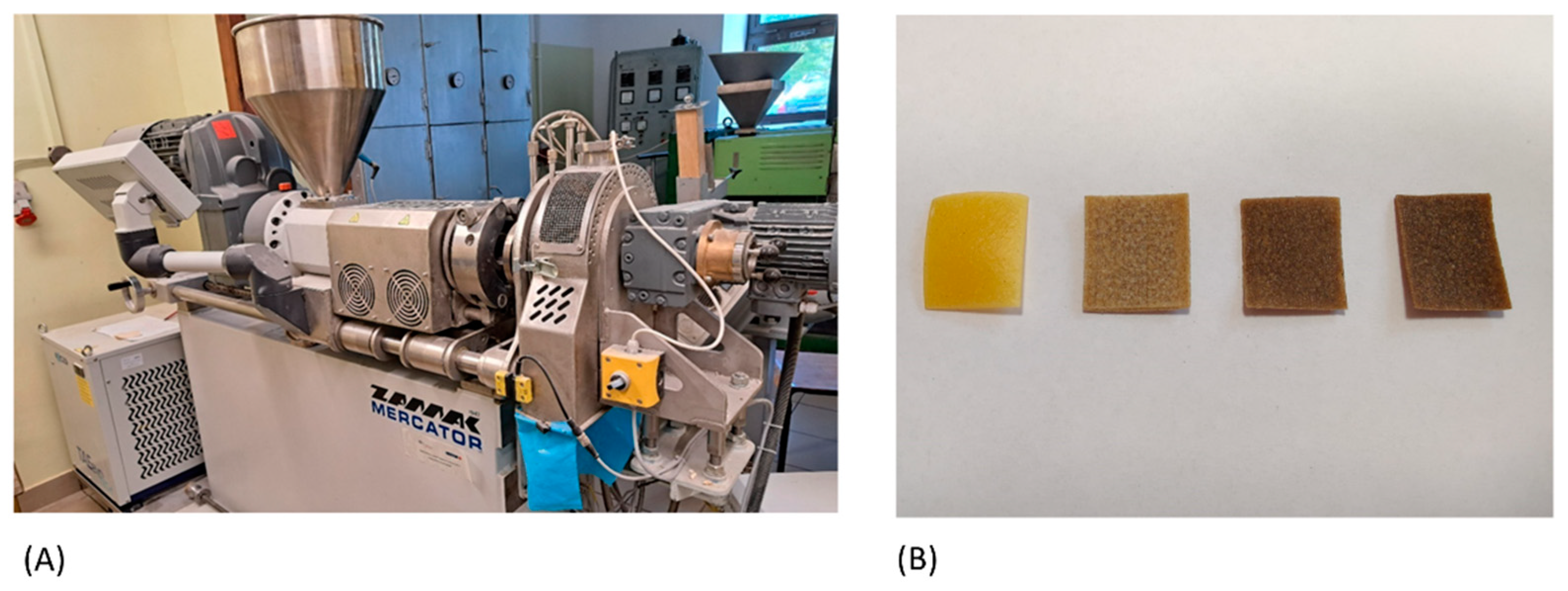
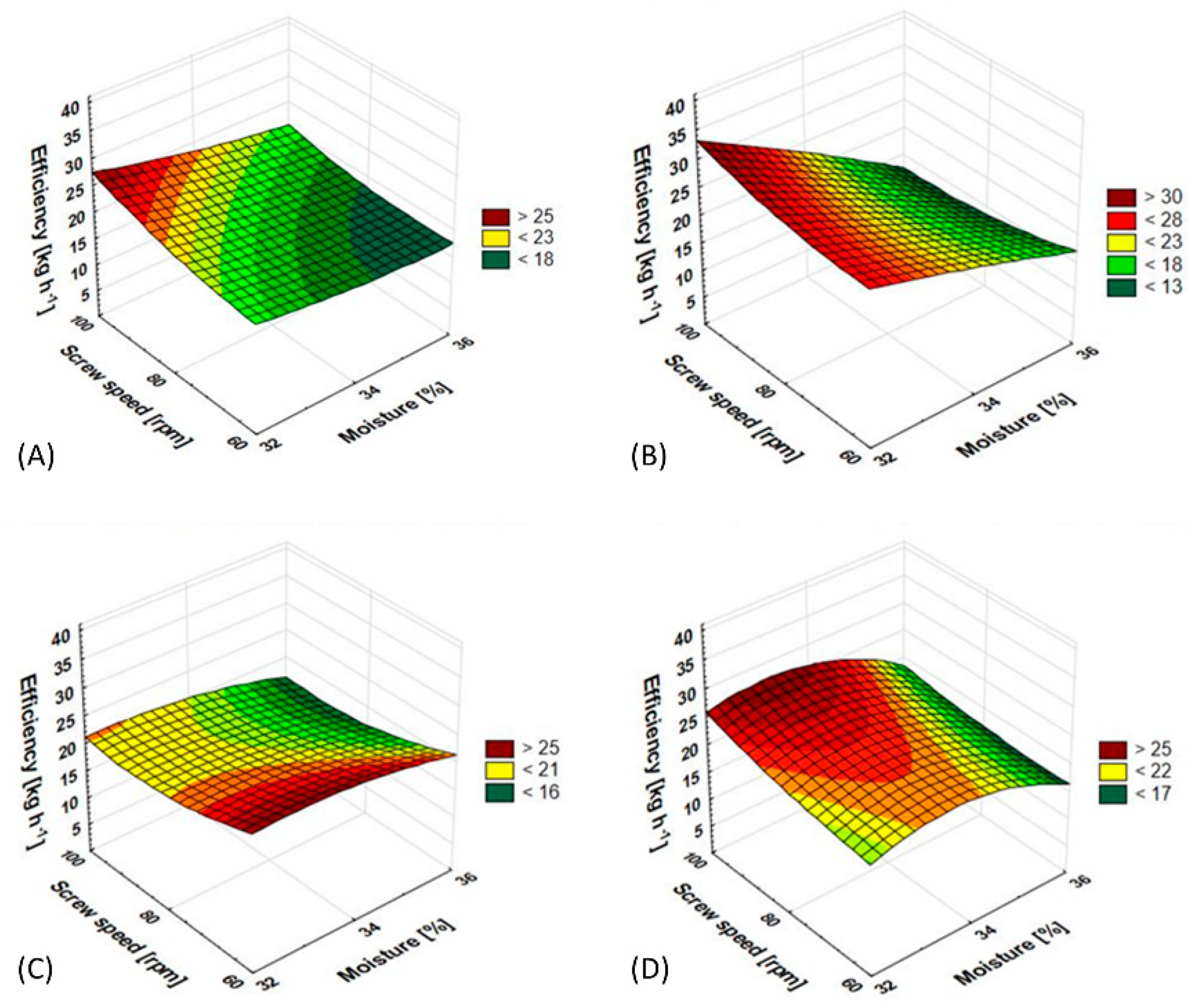
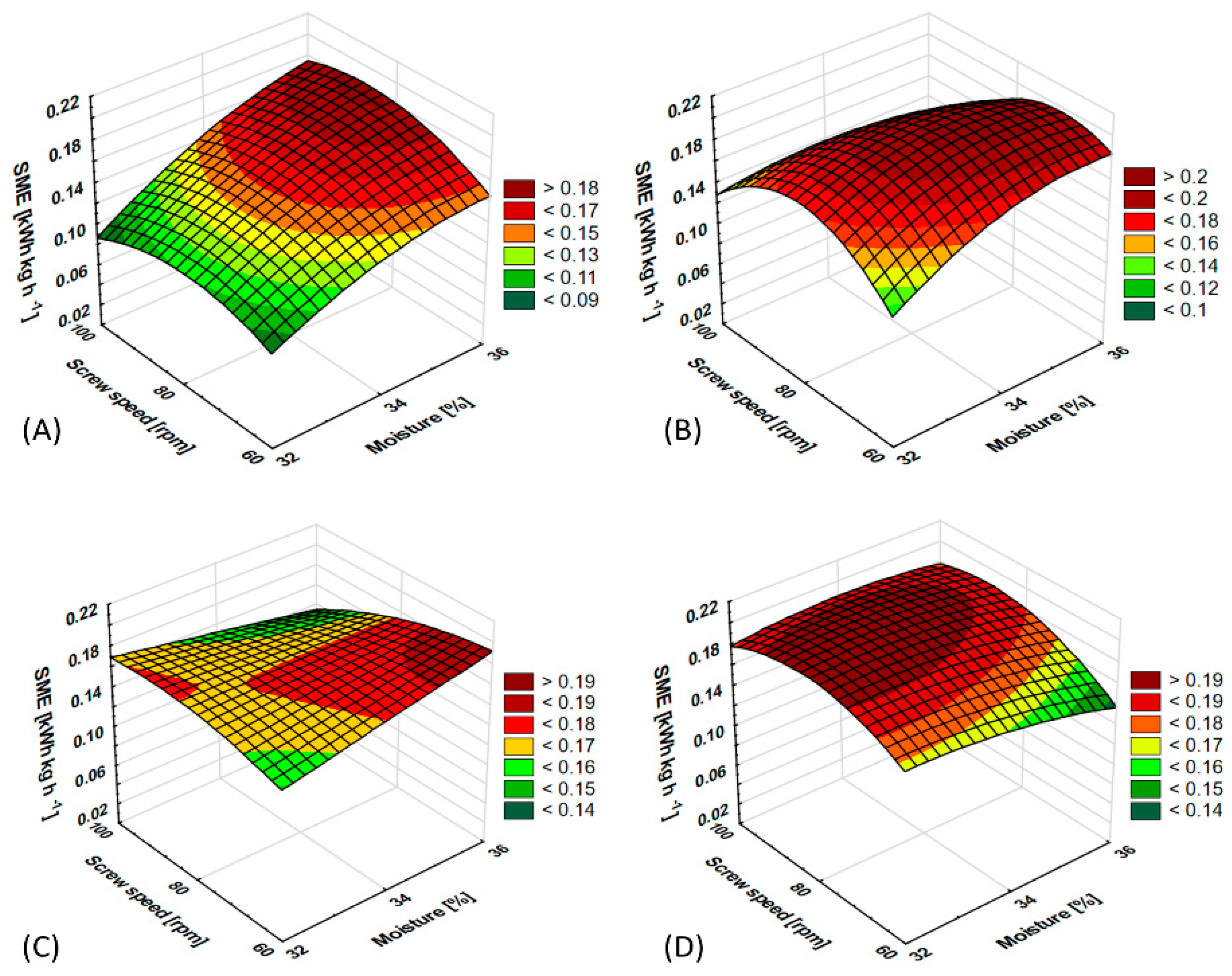

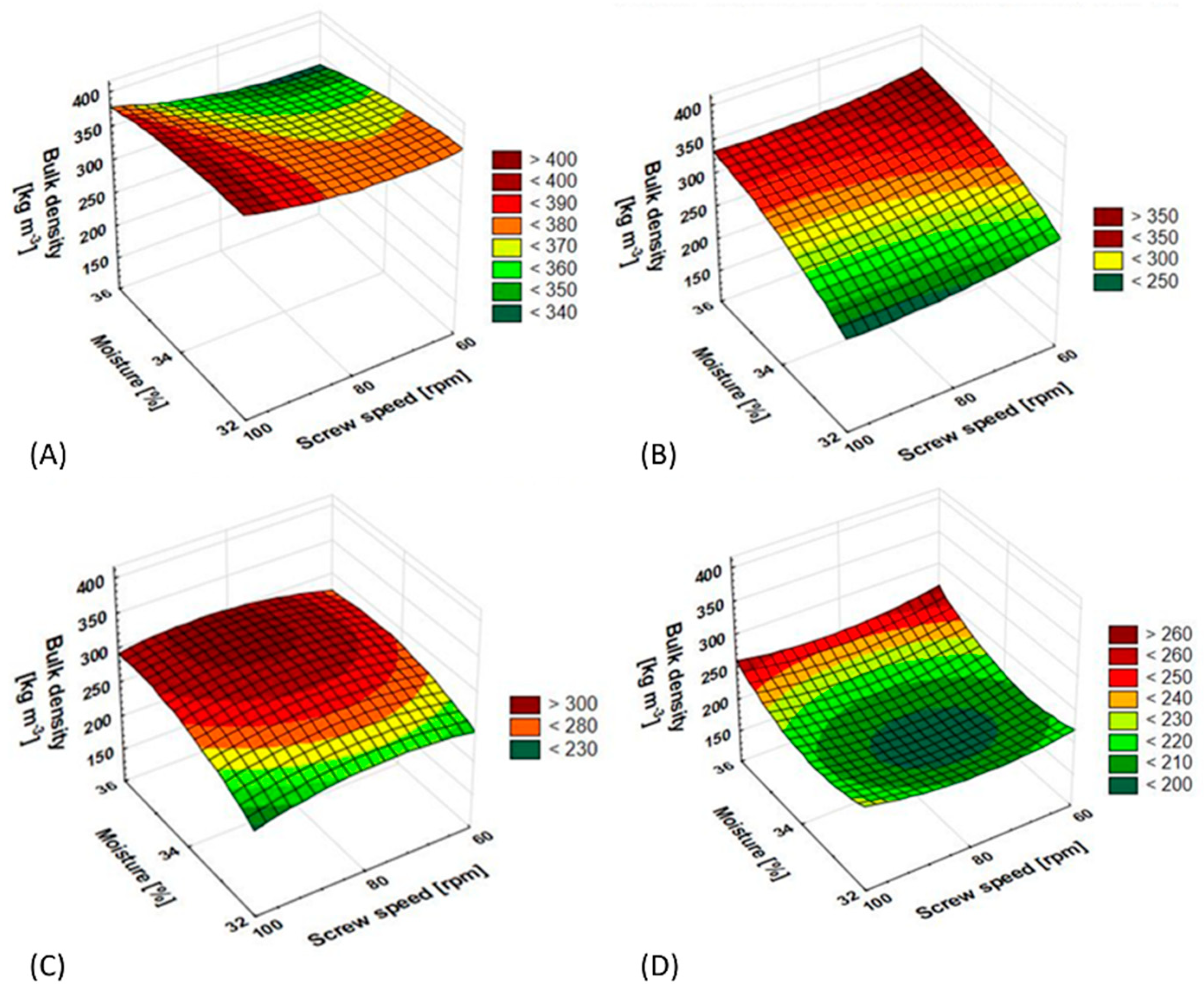
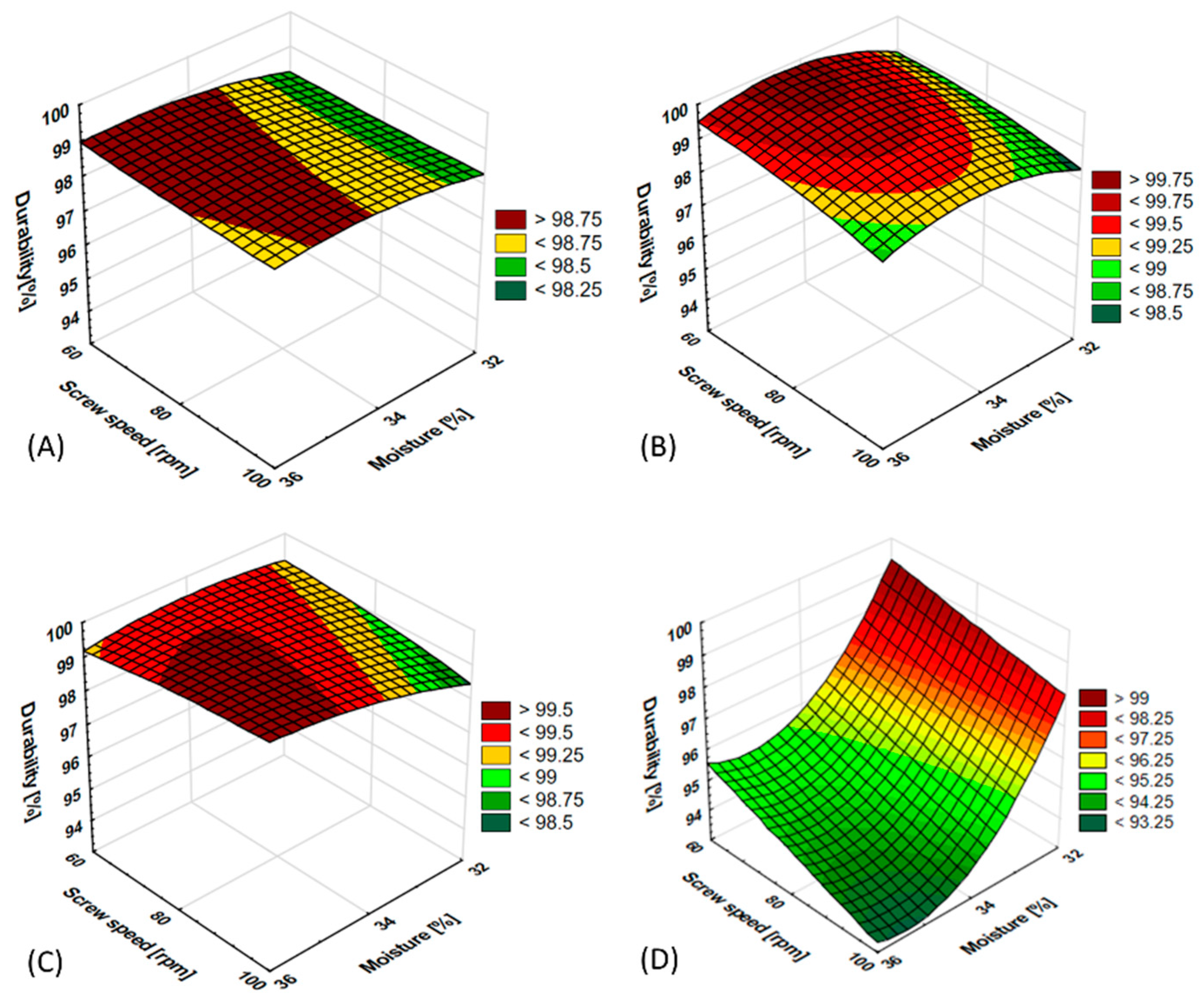
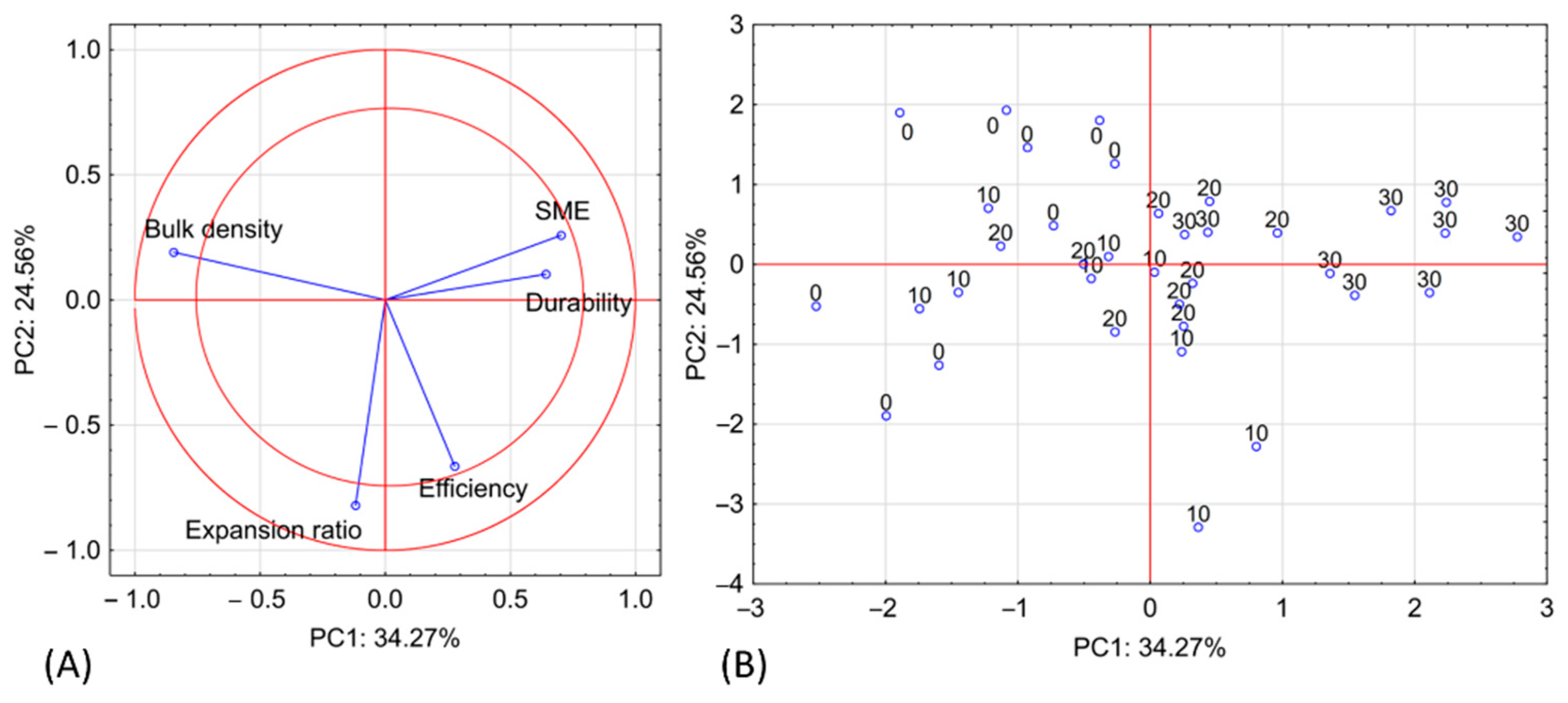
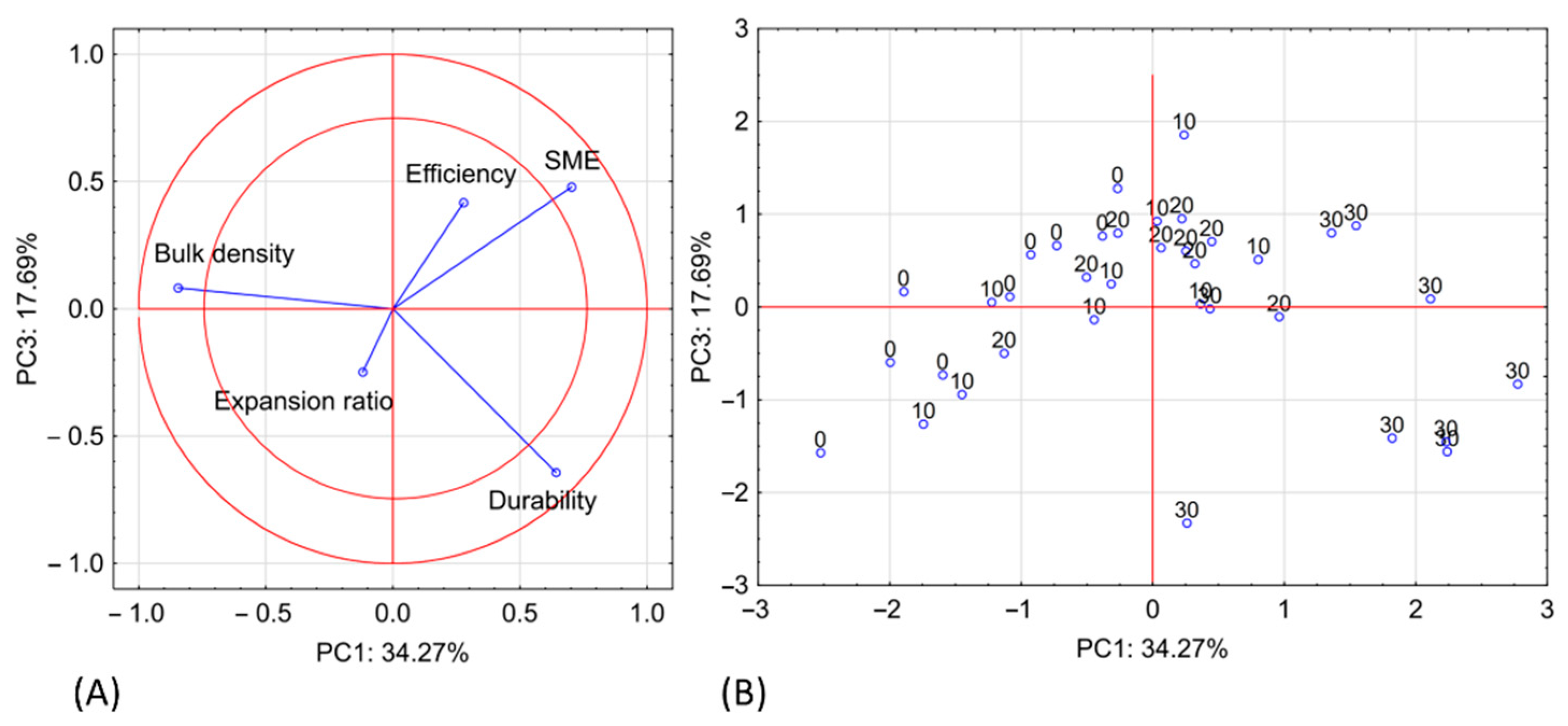
Disclaimer/Publisher’s Note: The statements, opinions and data contained in all publications are solely those of the individual author(s) and contributor(s) and not of MDPI and/or the editor(s). MDPI and/or the editor(s) disclaim responsibility for any injury to people or property resulting from any ideas, methods, instructions or products referred to in the content. |
© 2023 by the authors. Licensee MDPI, Basel, Switzerland. This article is an open access article distributed under the terms and conditions of the Creative Commons Attribution (CC BY) license (https://creativecommons.org/licenses/by/4.0/).
Share and Cite
Wójtowicz, A.; Combrzyński, M.; Biernacka, B.; Oniszczuk, T.; Mitrus, M.; Różyło, R.; Gancarz, M.; Oniszczuk, A. Application of Edible Insect Flour as a Novel Ingredient in Fortified Snack Pellets: Processing Aspects and Physical Characteristics. Processes 2023, 11, 2561. https://doi.org/10.3390/pr11092561
Wójtowicz A, Combrzyński M, Biernacka B, Oniszczuk T, Mitrus M, Różyło R, Gancarz M, Oniszczuk A. Application of Edible Insect Flour as a Novel Ingredient in Fortified Snack Pellets: Processing Aspects and Physical Characteristics. Processes. 2023; 11(9):2561. https://doi.org/10.3390/pr11092561
Chicago/Turabian StyleWójtowicz, Agnieszka, Maciej Combrzyński, Beata Biernacka, Tomasz Oniszczuk, Marcin Mitrus, Renata Różyło, Marek Gancarz, and Anna Oniszczuk. 2023. "Application of Edible Insect Flour as a Novel Ingredient in Fortified Snack Pellets: Processing Aspects and Physical Characteristics" Processes 11, no. 9: 2561. https://doi.org/10.3390/pr11092561
APA StyleWójtowicz, A., Combrzyński, M., Biernacka, B., Oniszczuk, T., Mitrus, M., Różyło, R., Gancarz, M., & Oniszczuk, A. (2023). Application of Edible Insect Flour as a Novel Ingredient in Fortified Snack Pellets: Processing Aspects and Physical Characteristics. Processes, 11(9), 2561. https://doi.org/10.3390/pr11092561









